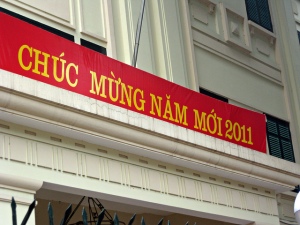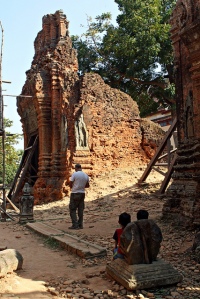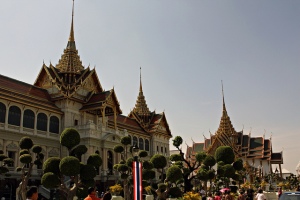The Ba Dinh district is an area in Hanoi that used to be called the French Quarter as there were many buildings with French colonial architecture in the area. Today this is where many government, political, embassy buildings, and some museums are located, including the Ba Dinh Square (where the Ho Chi Minh Complex is) and the Temple of Literature at the southern edge of the district.
After our visit to the Ho Chi Minh Complex, we continued our Hanoi sightseeing trip with a walk to the Temple of Literature, our next destination. The walk was not that far, about 3-4 large city blocks on the map that took us around 15 minutes or so. During the walk we noticed the difference in the landscape as compared to the Old Quarter where we stayed. The Old Quarter was very dense with small streets and narrow buildings, and the area seemed to evolve organically over the time. The Ba Dinh district area on the other hand seemed to be more spread out, with lots of trees around, and it seemed to be laid out in a planned manner. We also saw that many of the buildings that we passed during the walk were government buildings, and I think we also passed a couple of embassies along the way. This reminded me to the Menteng area in the Central Jakarta that shared similar characteristics, very green and filled with important government buildings and foreign attaches.
Another interesting observation was seeing the banner saying ‘chúc mừng năm mới 2011’ on many of the buildings. They are all written in yellow scripts on red background — two colors that were prevalent everywhere in the city. I didn’t know the meaning, but the 2011 part gave it away — it was ‘Happy New Year 2011’ sign (as it was January 2nd, 2011 when we visited the city). I didn’t expect to see this as widely celebrated as from what I read, the biggest celebration of the year is actually the Vietnamese Lunar New Year (Tết) which usually is celebrated around the same time as the Chinese Lunar New Year. I guess with Hanoi becoming a popular tourist destination, the western/international culture also influenced the locals.
The photo below was taken during that walk. It was one of those signs that we saw. I couldn’t help to notice the color selection. Both colors apparently are quite important colors in the Vietnamese (and its Chinese influence) culture. Red symbolizes joy or happiness and yellow symbolizes wealth — both are what you wish for the new year. However, they’re also the standard colors for the international communism, so I guess they might have double meanings here.





